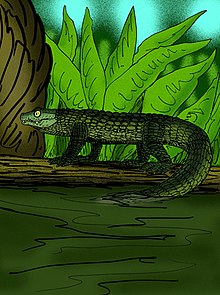Mekosuchus
| Mekosuchus | |
|---|---|

| |
| Mekosuchus inexpectatus mandible | |
| Scientific classification | |
| Kingdom: | Animalia |
| Phylum: | Chordata |
| Class: | Reptilia |
| Order: | Crocodilia |
| Clade: | †Mekosuchinae |
| Tribe: | †Mekosuchini |
| Genus: | †Mekosuchus Balouet & Buffetaut, 1987 |
| Type species | |
| †Mekosuchus inexpectatus Balouet & Buffetaut, 1987
| |
| Species | |
| |
Mekosuchus is a genus of extinct Australasian crocodiles within the subfamily Mekosuchinae. They are believed to have been made extinct by the arrival of humans on the South Pacific islands where they lived.[1] The species of this genus were small in size, 2 m in maximum length, and terrestrial, making them the last surviving group of fully terrestrial crocodilians,[2] leaving only semi-terrestrial species such as the Cuban crocodile and the dwarves Osteolaemus and Paleosuchus.[3]
Fossils of related mekosuchines, such as Trilophosuchus, have been found from Miocene Australia (the earliest known mekosuchine is the Eocene genus Kambara), while Quinkana survived until the arrival of humans.[4] Mekosuchus survived until the Holocene, and their sub-fossils have been found in New Caledonia and Vanuatu.
Species[]

There are currently four species of Mekosuchus recognised. The first discovered (and youngest) is the type species M. inexpectatus from the Holocene of New Caledonia which became extinct at some point in the last 4,000 years, most likely with the arrival of humans in the archipelago.[5] Mekosuchus had specialized back teeth for cracking mollusk shells and arthropod carapaces, an adaptation in response to the lack of large ground-dwelling prey in New Caledonia; although it was likely also an opportunistic hunter that went after lizards and various-sized birds when possible.
Another Holocene species is known, M. kalpokasi which lived on the island of Éfaté, Vanuatu approximately 3,000 years ago (again disappearing with the arrival of man).[6]
M. whitehunterensis, the oldest known species, lived during the late Oligocene in Queensland, Australia.[7] M. sanderi also lived in Queensland but later, during the Miocene.[citation needed]
Phylogeny[]
A 2018 tip dating study by Lee & Yates simultaneously using morphological, molecular (DNA sequencing), and stratigraphic (fossil age) data established the inter-relationships within Crocodilia,[8] which was expanded upon in 2021 by Hekkala et al. using paleogenomics by extracting DNA from the extinct Voay.[9]
The below cladogram from the latest studies shows the placement of Mekosuchus within Mekosuchinae:[8]
| Crocodylia |
| ||||||||||||||||||||||||||||||||||||||||||||||||||||||||||||||||||||||||||||||||||||||||||||||||||||||||||||||||||||||||||||||||||||||||||||||||||||||||||||
See also[]
References[]
- ^ Cf. The Recently Extinct Plants and Animals Database: Extinct Reptiles: Mekosuchus inexpectatus Archived 2016-03-04 at the Wayback Machine, noting Anderson, Atholl, Sand, Christophe, Petchey, Fiona and Worthy, Trevor H. (2010). "Faunal Extinction and Human Habitation in New Caledonia: Initial Results and Implications of New Research at the Pindai Caves", Journal of Pacific Archaeology 1.1: 89-109; M. kalpokasi, sp. nov.(J.I. Mead, D.W. Steadman, et al., "New extinct Mekosuchine crocodile from Vanuatu, South Pacific", Copeia, 2002.3: "the extinction of M. kalpokasi and other insular mekosuchines may have been anthropogenic"); .
- ^ "Croco eusuchia". Paleopedia.free.fr. Archived from the original on 2012-02-08. Retrieved 2012-05-23.
- ^ Darren Naish, "Tetrapod Zoology" (Scientific American blog): "Dissecting a crocodile", 2012
- ^ Roberts, R.G., Flannery, T.F., Ayliffe, L.K., Yoshida, H., Olley J.M., Prideaux, G.J., Laslett, G.M., Baynes, A., Smith, M.A., Jones, R., Smith, B.L. (2001). New Ages for the Last Australian Megafauna: Continent-Wide Extinction About 46,000 Years Ago. Science 292 (5523): 1888-1892. DOI: 10.1126/science.1060264
- ^ Anderson, S; Sand, C; Petchey, F; Worthy, T. H (2010). "Faunal extinction and human habitation in New Caledonia: Initial results and implications of new research at the Pindai Caves". Journal of Pacific Archaeology. 1 (1). Retrieved 2021-02-23.
- ^ Spriggs, Matthew; Bedford, Stuart. "The Archaeology of Vanuatu: 3,000 Years of History across Islands of Ash and Coral". Oxford Handbooks Online. Oxford University Press. Retrieved 22 August 2020.
- ^ Mead, Jim I; Steadman, David W; Bedford, Stuart H; Bell, Christopher J; Spriggs, Matthew (2002-08-21). "New Extinct Mekosuchine Crocodile from Vanuatu, South Pacific". Copeia. 2 (3): 632. doi:10.1643/0045-8511(2002)002[0632:NEMCFV]2.0.CO;2. Retrieved 2021-02-23.
- ^ Jump up to: a b Michael S. Y. Lee; Adam M. Yates (27 June 2018). "Tip-dating and homoplasy: reconciling the shallow molecular divergences of modern gharials with their long fossil". Proceedings of the Royal Society B. 285 (1881). doi:10.1098/rspb.2018.1071. PMC 6030529. PMID 30051855.
- ^ Hekkala, E.; Gatesy, J.; Narechania, A.; Meredith, R.; Russello, M.; Aardema, M. L.; Jensen, E.; Montanari, S.; Brochu, C.; Norell, M.; Amato, G. (2021-04-27). "Paleogenomics illuminates the evolutionary history of the extinct Holocene "horned" crocodile of Madagascar, Voay robustus". Communications Biology. 4 (1): 505. doi:10.1038/s42003-021-02017-0. ISSN 2399-3642. PMC 8079395. PMID 33907305.
- Mead, J.I., Steadman, D.W., Bedford, S.H., Bell, C.J. & Spriggs, M. (2002). New extinct mekosuchine crocodile from Vanuatu, South Pacific. Copeia 2002 (3): 632-641
Bibliography[]
The Future Eaters by Tim Flannery.
- Mekosuchinae
- Neogene crocodylomorphs
- Oligocene crocodylomorphs
- Miocene crocodylomorphs
- Terrestrial crocodylomorphs
- New Caledonia Holocene fauna
- Holocene extinctions
- Pliocene crocodylomorphs
- Pleistocene crocodylomorphs
- Taxa named by Jean-Christophe Balouet
- Prehistoric pseudosuchian genera

